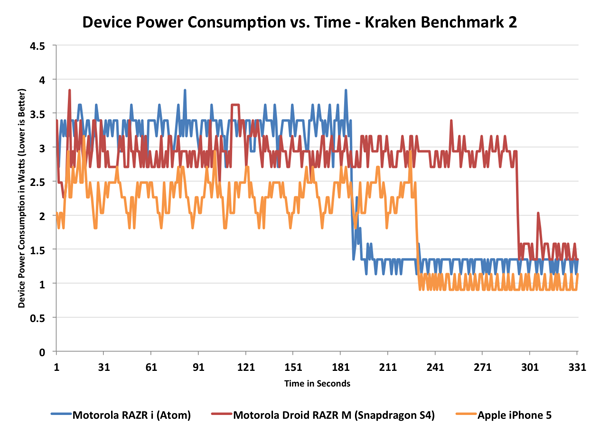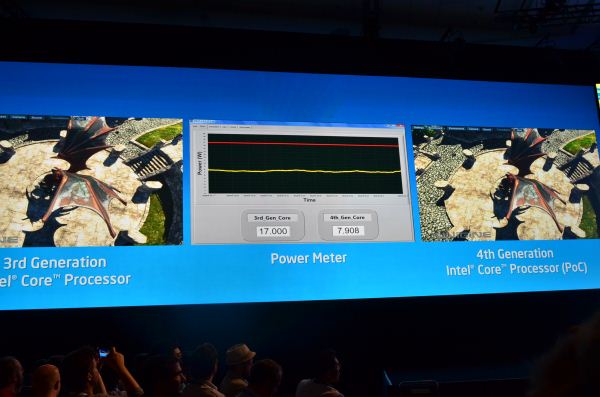The ARM vs x86 Wars Have Begun: In-Depth Power Analysis of Atom, Krait & Cortex A15
by Anand Lal Shimpi on January 4, 2013 7:32 AM EST- Posted in
- Tablets
- Intel
- Samsung
- Arm
- Cortex A15
- Smartphones
- Mobile
- SoCs
Final Words
Whereas I didn't really have anything new to conclude in the original article (Atom Z2760 is faster and more power efficient than Tegra 3), there's a lot to talk about here. We already know that Atom is faster than Krait, but from a power standpoint the two SoCs are extremely competitive. At the platform level Intel (at least in the Acer W510) generally leads in power efficiency. Note that this advantage could just as easily be due to display and other power advantages in the W510 itself and not necessarily indicative of an SoC advantage.
Looking at the CPU cores themselves, Qualcomm takes the lead. It's unclear how things would change if we could include L2 cache power consumption for Qualcomm as we do for Intel (see page 2 for an explanation). I suspect that Qualcomm does maintain the power advantage here though, even with the L2 cache included.
On the GPU side, Intel/Imagination win there although the roles reverse as Adreno 225 holds a performance advantage. For modern UI performance, the PowerVR SGX 545 is good enough but Adreno 225 is clearly the faster 3D GPU. Intel has underspecced its ultra mobile GPUs for a while, so a lot of the power advantage is due to the lower performing GPU. In 2D/modern UI tests however, the performance advantage isn't realized and thus the power advantage is still valid.
Qualcomm is able to generally push to lower idle power levels, indicating that even Intel's 32nm SoC process is getting a little long in the tooth. TSMC's 28nm LP and Samsung's 32nm LP processes both help silicon built in those fabs drive down to insanely low idle power levels. That being said, it is still surprising to me that a 5-year-old Atom architecture paired with a low power version of a 3-year-old process technology can be this competitive. In the next 9 - 12 months we'll finally get an updated, out-of-order Atom core built on a brand new 22nm low power/SoC process from Intel. This is one area where we should see real improvement. Intel's chances to do well in this space are good if it can manage to execute well and get its parts into designs people care about.

Device level power consumption, from our iPhone 5 review, look familiar?
If the previous article was about busting the x86 power myth, one key takeaway here is that Intel's low power SoC designs are headed in the right direction. Atom's power curve looks a lot like Qualcomm's, and I suspect a lot like Apple's. There are performance/power tradeoffs that all three make, but they're all being designed the way they should.
The Cortex A15 data is honestly the most intriguing. I'm not sure how the first A15 based smartphone SoCs will compare to Exynos 5 Dual in terms of power consumption, but at least based on the data here it looks like Cortex A15 is really in a league of its own when it comes to power consumption. Depending on the task that may not be an issue, but you still need a chassis that's capable of dissipating 1 - 4x the power of a present day smartphone SoC made by Qualcomm or Intel. Obviously for tablets the Cortex A15 can work just fine, but I am curious to see what will happen in a smartphone form factor. With lower voltage/clocks and a well architected turbo mode it may be possible to deliver reasonable battery life, but simply tossing the Exynos 5 Dual from the Nexus 10 into a smartphone isn't going to work well. It's very obvious to me why ARM proposed big.LITTLE with Cortex A15 and why Apple designed Swift.
I'd always heard about Haswell as the solution to the ARM problem, particularly in reference to the Cortex A15. The data here, particularly on the previous page, helped me understand exactly what that meant. Under a CPU or GPU heavy workload, the Exynos 5 Dual will draw around 4W. Peak TDP however is closer to 8W. If you remember back to IDF, Intel specifically called out 8W as a potential design target for Haswell. In reality, I expect that we'll see Haswell parts even lower power than that. While it may still be a stretch to bring Haswell down to 4W, it's very clear to me that Intel sees this as a possiblity in the near term. Perhaps not at 22nm, but definitely at 14nm. We already know Core can hit below 8W at 22nm, if it can get down to around 4W then that opens up a whole new class of form factors to a traditionally high-end architecture.
Ultimately I feel like that's how all of this is going to play out. Intel's Core architectures will likely service the 4W and above space, while Atom will take care of everything else below it. The really crazy part is that it's not too absurd to think about being able to get a Core based SoC into a large smartphone as early as 14nm, and definitely by 10nm (~2017) should the need arise. We've often talked about smartphones being used as mainstream computing devices in the future, but this is how we're going to get there. By the time Intel moves to 10nm ultramobile SoCs, you'll be able to get somewhere around Sandy/Ivy Bridge class performance in a phone.
At the end of the day, I'd say that Intel's chances for long term success in the tablet space are pretty good - at least architecturally. Intel still needs a Nexus, iPad or other similarly important design win, but it should have the right technology to get there by 2014. It's up to Paul or his replacement to ensure that everything works on the business side.
As far as smartphones go, the problem is a lot more complicated. Intel needs a good high-end baseband strategy which, as of late, the Infineon acquisition hasn't been able to produce. I've heard promising things in this regard but the baseband side of Intel remains embarassingly quiet. This is an area where Qualcomm is really the undisputed leader, Intel has a lot of work ahead of it here. As for the rest of the smartphone SoC, Intel is on the right track. Its existing architecture remains performance and power competitive with the best Qualcomm has to offer today. Both Intel and Qualcomm have architecture updates planned in the not too distant future (with Qualcomm out of the gate first), so this will be one interesting battle to watch. If ARM is the new AMD, then Krait is the new Athlon 64. The difference is, this time, Intel isn't shipping a Pentium 4.











140 Comments
View All Comments
kumar0us - Friday, January 4, 2013 - link
My point was that for a CPU benchmark say Sunspider, the code generated by x86 compilers would be better than ARM compilers.Could better compilers available for x86 platform be a (partial) reason for faster performance of intel. Or compilers for ARM platform are mature and fast enough that this angle could be discarded?
iwod - Friday, January 4, 2013 - link
Yes, not just compiler but general optimization in software on x86. Which is giving some advantage on Intel's side. However with the recent surge of ARM platform and software running on it my ( wild ) guess is that this is less then 5% in the best case scenario. And it is only the worst case, or individual cases like SunSpider not running fully well.jwcalla - Friday, January 4, 2013 - link
Yes. And it was a breath of fresh air to see Anand mention that in the article.Look at, e.g., the difference in SunSpider benchmarks between the iPad and Nexus 10. Completely different compilers and completely different software. As the SunSpider website indicates, the benchmark is designed to compare browsers on the same system, not across different systems.
monstercameron - Friday, January 4, 2013 - link
it would be interesting to throw an amd system into the benchmarking, maybe the current z-01 or the upcoming z-60...silverblue - Friday, January 4, 2013 - link
AMD has thrown a hefty GPU on die, which, coupled with the 40nm process, isn't going to help with power consumption whatsoever. The FCH is also separate as opposed to being on-die, and AMD tablets seem to be thicker than the competition.AMD really needs Jaguar and its derivatives and now. A dual core model with a simple 40-shader GPU might be a competitive part, though I'm always hearing about the top-end models which really aren't aimed at this market. Perhaps AMD will use some common sense and go for small, volume parts over the larger, higher performance offerings, and actually get themselves into this market.
BenSkywalker - Friday, January 4, 2013 - link
There is an AMD design in their, Qualcomm's part.A D R E N O
R A D E O N
Not a coincidence, Qualcomm bought AMD's ultra portable division off from them for $65 million a few years back.
Anand- If this is supposed to be a CPU comparison, why go overboard with the terrible browser benchmarks? Based on numbers you have provided, Tegra 3 as a generic example is 100% faster under Android then WinRT depending on the bench you are running. If this was an article about how the OSs handle power tasks I would say that is reasonable, but given that you are presenting this as a processor architecture article I would think that you would want to use the OS that works best with each platform.
powerarmour - Friday, January 4, 2013 - link
Agreed, those browser benchmarks seem a pretty poor way to test general CPU performance, in fact browser benchmarks in general just test how optimized a particular browser is on a particular OS mainly.In fact I can beat most of those results with a lowly dual-A9 Galaxy Nexus smartphone running Android 4.2.1!
Pino - Friday, January 4, 2013 - link
I remember AMD having a dual core APU (Ontario) with a 9W TDP, on a 40nm process, back in 2010.They should invest on a SOC
kyuu - Friday, January 4, 2013 - link
That's what Temash is going to be. They just need to get it on the market and into products sooner rather than later.jemima puddle-duck - Friday, January 4, 2013 - link
Impressive though all this engineering is, in the real world what is the unique selling point for this? Normal people (not solipsistic geeks) don't care what's inside their phone, and the promise of their new phone being slighty faster than another phone is irrelevant. And for manufacturers, why ditch decades of ARM knowledge to lock yourself into one supplier. The only differentiator is cost, and I don't see Intel undercutting ARM any time soon.The only metric that matters is whether normal human beings get any value from it. This just seems like (indirect) marketing by Intel for a chip that has no raison d'etre. I'm hearing lots of "What" here, but no "Why". This is the analysis I'm interested in.
All that said, great article :)